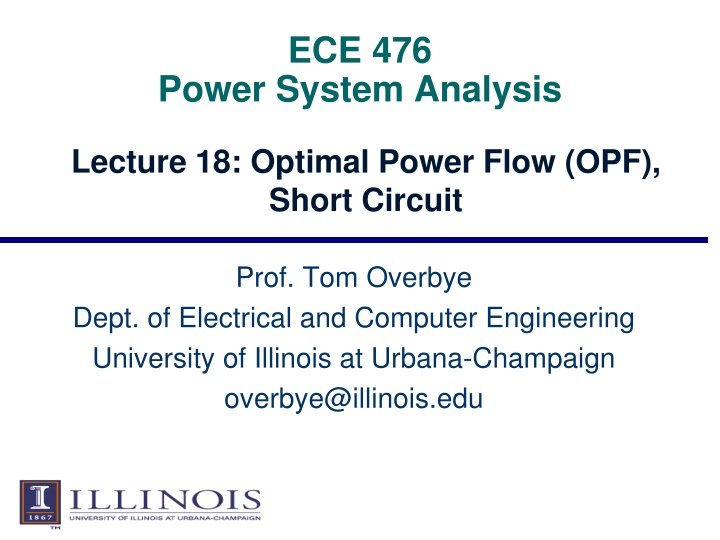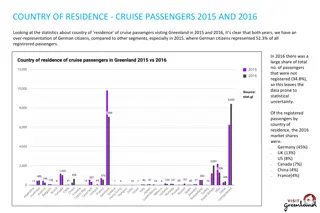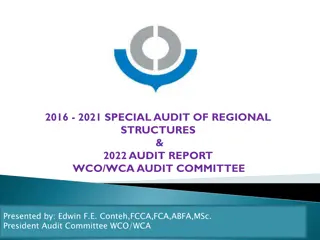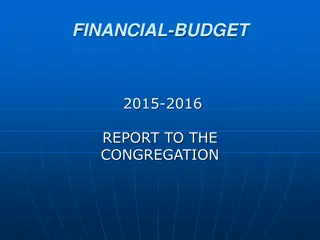
Optimal Power Flow in Power System Analysis
Optimal Power Flow (OPF) is a critical aspect of power system analysis, combining power flow calculations with economic dispatch considerations. This lecture delves into the calculation of penalty factors, two-bus penalty factor examples, and an in-depth example demonstrating various parameters in a power system. The lecture explores the complexities involved in optimizing power flow to minimize costs while adhering to realistic constraints and limitations in power systems.
Download Presentation

Please find below an Image/Link to download the presentation.
The content on the website is provided AS IS for your information and personal use only. It may not be sold, licensed, or shared on other websites without obtaining consent from the author. If you encounter any issues during the download, it is possible that the publisher has removed the file from their server.
You are allowed to download the files provided on this website for personal or commercial use, subject to the condition that they are used lawfully. All files are the property of their respective owners.
The content on the website is provided AS IS for your information and personal use only. It may not be sold, licensed, or shared on other websites without obtaining consent from the author.
E N D
Presentation Transcript
ECE 476 Power System Analysis Lecture 18: Optimal Power Flow (OPF), Short Circuit Prof. Tom Overbye Dept. of Electrical and Computer Engineering University of Illinois at Urbana-Champaign overbye@illinois.edu
Announcements Please read Chapters 7 and 8 HW 7 is 6.62, 6.63, 6.69, 6.71 due on Oct 27; this one must be turned in on Oct 27 (hence there will be no quiz that day) Optional Reading: Analytic Research Foundations for the Next-Generation Electric Grid, The National Academies Press, 2016 Exam 2 is during class on Tuesday November 15 Final exam is on Monday December 12, 1:30-4:30pm 1
Calculation of Penalty Factors Unfortunately, the analytic calculation of L is somewhat involved. The problem is a small change in the generation at P impacts the flows and hence the losses throughout the entire system. However, using a power flow you can approximate this function by making a small change to P and then seeing how the losses change: ( ) ( ) L G L G P P P P P P i Gi Gi 1 P P P L i ( ) L G 1 Gi Gi Gi 2
Two Bus Penalty Factor Example P P ( ) ( ) 0.37 10 P P P L MW MW L P = G L G 0.0387 = = = 0.037 2 0.9627 G Gi 0.9643 L 2 2 3
Example 6.22 58 MW 56 MW 39 MW 39 MW 78 MW 29 Mvar A A 39% MVA 21% MVA 1.05 pu 0.99 pu 3 4 1 1.00 pu 130.0 MW 72 MW 52 MW 147 MW 39 Mvar 46 MW 0.0000 AGC ON 92.5 MW slack -0.0825 AGC ON A A 53% MVA 46% MVA A A 38% MVA 48% MVA 54 MW 20 MW 71 MW A 47 MW 60% MVA 1.04 pu 0.96 pu 112 MW 107 MW 5 2 181.9 MW 39 MW 20 Mvar 127 MW 39 Mvar -0.0274 AGC ON Load Scalar: 1.00 Total Hourly Cost: 5916.04 $/h MW Losses: 12.44 MW Total Area Load: Marginal Cost ($/MWh): 392.0 MW 0.00 $/MWh
Optimal Power Flow (OPF) OPF functionally combines the power flow with economic dispatch Minimize cost function, such as operating cost, taking into account realistic equality and inequality constraints Equality constraints bus real and reactive power balance generator voltage setpoints area MW interchange 5
OPF, contd Inequality constraints transmission line/transformer/interface flow limits generator MW limits generator reactive power capability curves bus voltage magnitudes (not yet implemented in Simulator OPF) Available Controls generator MW outputs transformer taps and phase angles 6
Two Example OPF Solution Methods Non-linear approach using Newton s method handles marginal losses well, but is relatively slow and has problems determining binding constraints Linear Programming fast and efficient in determining binding constraints, but can have difficulty with marginal losses. used in PowerWorld Simulator 7
LP OPF Solution Method Solution iterates between solving a full ac power flow solution enforces real/reactive power balance at each bus enforces generator reactive limits system controls are assumed fixed takes into account non-linearities solving a primal LP changes system controls to enforce linearized constraints while minimizing cost 8
Two Bus with Unconstrained Line With no overloads the OPF matches the economic dispatch Transmission line is not overloaded Total Hourly Cost : Area Lambda : 13.01 8459 $/hr Bus B Bus A 13.01 $/MWh 13.01 $/MWh 300.0 MW MW 300.0 MW MW 197.0 MW AGC ON MW 403.0 MW AGC ON MW Marginal cost of supplying power to each bus (locational marginal costs) 9
Two Bus with Constrained Line Total Hourly Cost : Area Lambda : 13.26 9513 $/hr Bus B Bus A 13.43 $/MWh 13.08 $/MWh 380.0 MW MW 300.0 MW MW 260.9 MW AGC ON MW 419.1 MW AGC ON MW With the line loaded to its limit, additional load at Bus A must be supplied locally, causing the marginal costs to diverge. 10
Three Bus (B3) Example Consider a three bus case (bus 1 is system slack), with all buses connected through 0.1 pu reactance lines, each with a 100 MVA limit Let the generator marginal costs be Bus 1: 10 $ / MWhr; Range = 0 to 400 MW Bus 2: 12 $ / MWhr; Range = 0 to 400 MW Bus 3: 20 $ / MWhr; Range = 0 to 400 MW Assume a single 180 MW load at bus 2 11
B3 with Line Limits NOT Enforced 60 MW 60 MW Bus 2 Bus 1 10.00 $/MWh 0.0 MW 10.00 $/MWh 120 MW 180.0 MW 120% 0 MW 60 MW 120% 120 MW Total Cost 1800 $/hr Line from Bus 1 to Bus 3 is over- loaded; all buses have same marginal cost 60 MW 10.00 $/MWh Bus 3 180 MW 0 MW 12
B3 with Line Limits Enforced 20 MW 20 MW Bus 2 Bus 1 10.00 $/MWh 60.0 MW 12.00 $/MWh 100 MW 120.0 MW 100% 0 MW 80 MW 100% 100 MW Total Cost 1920 $/hr LP OPF redispatches to remove violation. Bus marginal costs are now different. 80 MW 14.00 $/MWh Bus 3 180 MW 0 MW 13
Verify Bus 3 Marginal Cost 19 MW 19 MW Bus 2 Bus 1 10.00 $/MWh 62.0 MW 12.00 $/MWh 100 MW 119.0 MW 100% 81% 0 MW 81 MW One additional MW of load at bus 3 raised total cost by 14 $/hr, as G2 went up by 2 MW and G1 went down by 1MW 100% 81% 100 MW Total Cost 1934 $/hr 81 MW 14.00 $/MWh Bus 3 181 MW 0 MW 14
Why is bus 3 LMP = $14 /MWh All lines have equal impedance. Power flow in a simple network distributes inversely to impedance of path. For bus 1 to supply 1 MW to bus 3, 2/3 MW would take direct path from 1 to 3, while 1/3 MW would loop around from 1 to 2 to 3. Likewise, for bus 2 to supply 1 MW to bus 3, 2/3MW would go from 2 to 3, while 1/3 MW would go from 2 to 1to 3. 15
Why is bus 3 LMP $ 14 / MWh, contd With the line from 1 to 3 limited, no additional power flows are allowed on it. To supply 1 more MW to bus 3 we need Pg1 + Pg2 = 1 MW 2/3 Pg1 + 1/3 Pg2 = 0; (no more flow on 1-3) Solving requires we up Pg2 by 2 MW and drop Pg1 by 1 MW -- a net increase of $14. 16
Both lines into Bus 3 Congested 0 MW 0 MW Bus 2 Bus 1 10.00 $/MWh 100.0 MW 12.00 $/MWh 100 MW 100.0 MW 100% 100% 0 MW For bus 3 loads above 200 MW, the load must be supplied locally. Then what if the bus 3 generator opens? 100 MW 100% 100% 100 MW Total Cost 2280 $/hr 100 MW 20.00 $/MWh Bus 3 204 MW 4 MW 17
MISO LMP Price Contour: 830am CDT Oct 24, 2016 Image Source: www.misoenergy.org/LMPContourMap/MISO_All.html 19
Power Markets (Sometimes Known as Independent System Operator) In many places markets are replacing many of the former planning and operation tools and functions MISO is an example of a such a market Goal is to replace regulated cost-plus system with competitive marketplaces underlying assumption is in the long-run with competition prices should decrease market should be designed so participants do not have to provide their true costs to a central authority Markets differ widely in what functions they provide 20
Example Energy Market ... ... Seller 1 Seller i Seller M MWh $ MWh $ MWh $ Market Operator MWh $ MWh $ MWh ... $ ... Buyer 1 Buyer j Buyer N 21
Need to Approximate Gen Curves $/hr Actual curve is approximated with a piecewise linear curve P (MW) 22
Market Receives Offers for Each Unit Unit 1 Offers Unit 1 Cost Blocks 5 4 3 2 1 0 1 2 3 23
Composite Offers for One Period Composite 10 9 8 1 7 2 3 6 4 5 5 6 7 4 8 9 3 10 2 1 0 1 2 3 4 5 6 7 8 9 10 24
Dispatch by Auction In its simplest form, an auction is a mechanism of allocating scarce goods based upon competition a seller wishes to obtain as much money as possible, and a buyer wants to pay as little as necessary. An auction is usually considered efficient if resources accrue to those who value them most highly Auctions can be either one-sided with a single monopolist seller/buyer or a double auction with multiple parties in each category 25
Auctions, contd In an auctions buyers make bids to buy, while sellers make offers to sell. The job of an auction is to provide a mechanism for participants to reveal their true costs while satisfying their desires to buy low and/or sell high. Auctions differ on the price participants receive and how much information they see along the way 26
Uniform Price Auctions Uniform price auctions are sealed offer auctions in which sellers make simultaneous decisions (done when they submit their offers). Generators can be paid either the last accepted offer (LAO) or paid the first rejected offer (FRO) This provides incentive to offer at marginal cost, since higher values could cause offers to be rejected thus reigning price should be a reliable signal of marginal cost Price caps are needed to prevent prices from rising up to infinity when there is limited supply 27
North American ISO/RTO Image Source: www.isorto.org
Fault Analysis The cause of electric power system faults is insulation breakdown This breakdown can be due to a variety of different factors lightning wires blowing together in the wind animals or plants coming in contact with the wires salt spray or pollution on insulators 29
Fault Types There are two main types of faults symmetric faults: system remains balanced; these faults are relatively rare, but are the easiest to analyze so we ll consider them first. unsymmetric faults: system is no longer balanced; very common, but more difficult to analyze The most common type of fault on a three phase system by far is the single line-to-ground (SLG), followed by the line-to-line faults (LL), double line-to-ground (DLG) faults, and balanced three phase faults 30

















